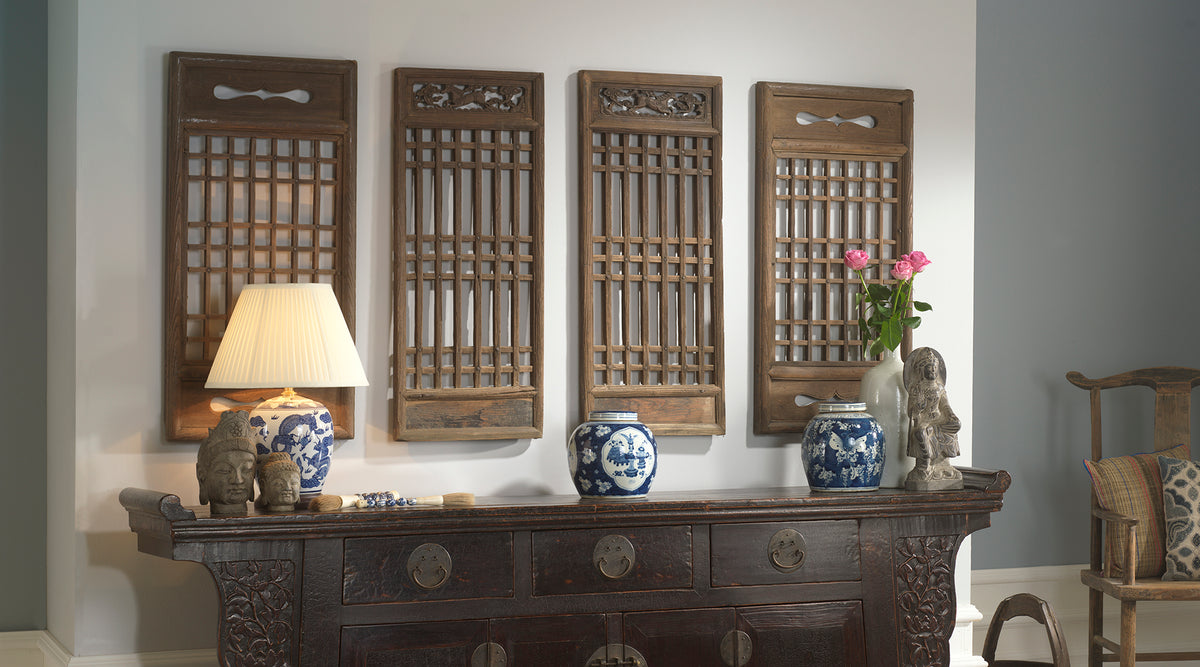
Screen Time: Create a stunning feature wall or room divider with our latest antiques
We were delighted recently to add a stunning selection of carved fretwork window panels and lattice screens to our collection of Chinese antique furniture. Amongst the extraordinary items we now have in stock is a set of sixteen carved panels, rescued from a traditional home in Zhejiang province in eastern China before the building was demolished for redevelopment.
Dating from the early eighteenth century, the panels are available in sets of four, with each set featuring richly detailed, intricate hand-carved scenes depicting Chinese folk tales. As such, they offer a unique and highly original way to add a touch of history to your home.
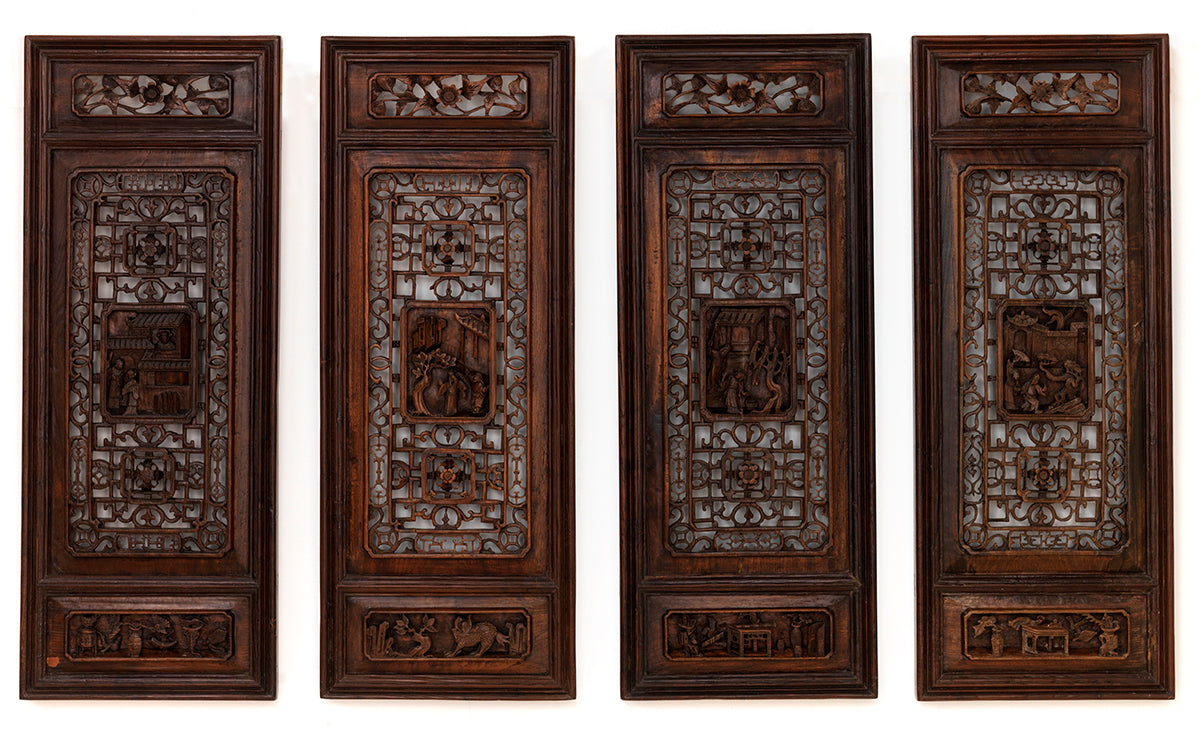 Decorative Chinese panels made to tell a story
Decorative Chinese panels made to tell a story
When in their original home, the sixteen panels would have been placed in a specific order to allow the viewer to follow the traditional folk story, with its cast of characters and various scenes played out across the carvings.
The extraordinary detail of the carved panels is testament to the skill of the woodworkers who made them all those decades ago and brings into clear relief everything from the flora and fauna of the landscape, through to the different figures and detailed buildings that form a background to the story.

As aficionados of antique Chinese furniture will know, nothing about the images used in the designs has been left to chance, and the open frame which surrounds each panel has been decorated with elements of flora and fauna with richly symbolic meaning. Images of bats, for example, are intended to represent good luck, whilst double coins denote prosperity. Furthermore, the bottoms of the panels have an additional delicately carved section, which – depending on the particular screen – may feature scenes from folklore, auspicious animals or valuable objects such as bronzes, vases or valuable furniture.
Carved Chinese screens designed to serve a practical purpose
Traditional Chinese screens and window panels were more than just decorative elements; they were integral components of home design, serving functional, symbolic, and aesthetic roles.
Functionally, these screens and panels were used to partition spaces within a house, offering privacy and helping to regulate the flow of movement. Being free-standing and relatively light, they could easily be repositioned according to need, creating temporary rooms or concealing certain areas from view. Wall or window panels allowed light to filter into an area in the home while maintaining privacy, a valuable feature in densely populated areas.
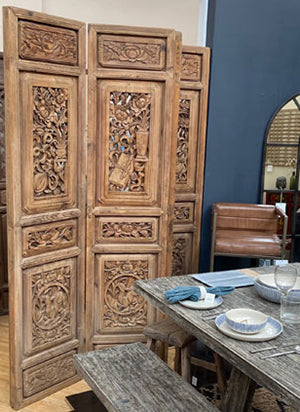
Aesthetically, screens and window panels added a layer of sophistication and beauty to the interior. The play of light through the intricate carvings created an interplay of shadows and highlights, bringing dynamic life to the otherwise static pieces. The grain and colour of the wood, enhanced by lacquered finishes, provided warmth and elegance.
The presence of these screens and panels within traditional Chinese homes underscored a seamless blend of form and function, making these pieces not just decorative artefacts but an integral part of daily life.
How were carved Chinese screens made?
Antique carved Chinese screens and window panels are excellent examples of the superb skill and craftsmanship of the master carvers of Zhejiang and other provinces in southern China, representing the pinnacle of a refined and intricate art form honed over centuries. The creation process of these screens and panels was both a technical and artistic achievement that required a broad range of skills, many of which now represent a dying art form.
The main material used in crafting these screens was typically a high-quality hardwood such as rosewood or sandalwood, selected for its durability, fine grain and the way it responded to being worked. However, softer woods were also used, often with the harder woods being employed for the intricate carving and the softer wood used in the backing or base.
The Chinese artisans used traditional wood joinery techniques, such as mortise and tenons and mitred joints, to assemble the panels. These methods allowed for a strong, seamless bond without the use of nails or screws. It is worth noting that this level of craftsmanship necessitated a deep understanding of wood properties and an innate precision.
The carving process was meticulous and time-consuming, requiring mastery and patience. Artisans used a range of chisels, gouges, and knives to create intricate scenes, often taking inspiration from Chinese mythology, nature or traditional symbols. This painstaking process might take weeks or even months for a single panel, depending on the complexity of the design.
The finished screens and panels were then finished with natural oils and waxes that not only enhanced the grain and colour of the wood but also protected it from the elements. This meticulous process resulted in a finished product that was not just functional, but a stunning work of art that continues to be appreciated centuries after its creation.
Antique Chinese screens – the perfect addition to contemporary interiors
Antique Chinese screens and window panels possess a timeless allure that makes them well-suited to incorporation into contemporary interiors. They offer an elegant solution to space management, privacy, and decorative needs, whilst also bringing a unique historical and cultural depth to a modern space.
In a contemporary open-plan layout, an antique Chinese screen can act as a visually stunning room divider, subtly demarcating different zones such as living and dining areas or a home office. They provide a sense of separation without disrupting the open flow of space, and can be moved as needed, allowing for flexible use of the area.
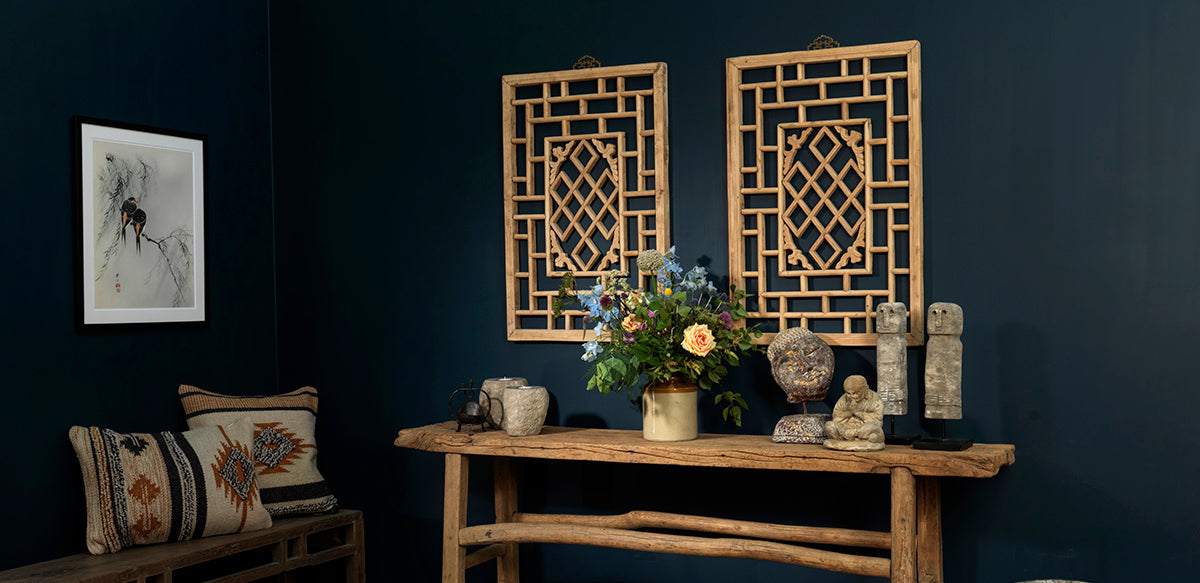 Chinese window panels can be repurposed into compelling art pieces, hanging on a wall or displayed in a stand. The intricate carvings become a focal point, adding texture and interest to a room. Alternatively, they can be used as part of a door or as a window insert to create beautiful patterns of light and shadow, or even converted into unique headboards for beds.
Chinese window panels can be repurposed into compelling art pieces, hanging on a wall or displayed in a stand. The intricate carvings become a focal point, adding texture and interest to a room. Alternatively, they can be used as part of a door or as a window insert to create beautiful patterns of light and shadow, or even converted into unique headboards for beds.
The use of these antique pieces allows for a striking fusion of old and new, traditional and contemporary. Their rich history and exquisite craftsmanship bring a unique character and warmth to modern interiors, ensuring they remain a cherished feature within any home.


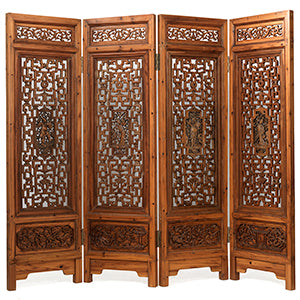



Leave a comment